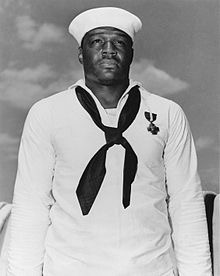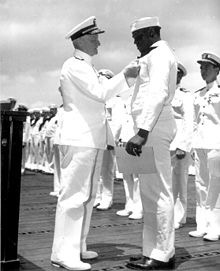His name was Doris, but he was built like a pro fullback. He was the first black American hero of WWII.
Born the son of a sharecropper in Waco, Texas, the 19 year old decided he wanted to earn money for the family and see the world. So in late 1939, he enlisted in the U.S. Navy.
After basic training at NAS Norfolk Virginia, he was assigned as a mess attendant 3rd class to the battleship USS West Virginia, considered to be one of the best vessels in the U.S. Pacific Fleet.
His athletic abilities caught the notice of the ship’s captain who thought sports activities were good for morale. “Dorie,” as his shipmates called him, decided to try boxing. It was a good choice. He shortly became the “Big Weevie’s” heavyweight champion.
Early on a balmy Sunday morning December 7th, 1941, the ships of The Fleet lay at anchor around Ford Island in Pearl Harbor, Hawaii. The anchorage was nicknamed “Battleship Row.” The unsuspecting sailors roused themselves and headed to the mess hall for breakfast and morning colors.
Below decks, Dorie Miller was starting another day of mundane tasks, prescribed duty for blacks in the segregated U.S. Navy at that time.
Suddenly, the sound of explosions shattered the Sunday peace. Over 360 Japanese torpedo bombers, dive-bombers and fighters swept over the island of Oahu and raked the ships, airfields and other military installations. The first wave of torpedo bombers came in low and fast over Battleship Row. Three battleships were struck almost immediately, the California, Oklahoma and West Virginia.
Hearing the explosions and feeling the ship lurch, Mess man Miller and other sailors scrambled topside to assist on deck. When they arrived, they saw a scene from hell. The “Big Weevie” was burning and severely damaged. Dorie saw ships burning all over the harbor. Men in the burning oil soaked water screamed for help.
Dorie joined fire and rescue parties and carried several of the wounded to safety. Afterwards, he jumped on one of the ship’s 50cal. antiaircraft machine guns. He had never been trained on the weapon, but quickly figured it out and began firing at strafing Japanese planes. “I actually downed four Japanese bombers,” he said later. He fired until he ran out of ammo and was ordered to abandon ship. He swam under water and around burning oil leaking from nearby ships.
His heroism went unnoticed for several months, until Lawrence Reddick, director of the Black Culture Center in New York learned of it. He lobbied the Navy to add Miller’s name to the list of Pearl Harbor heroes.
The black and white press picked up on the story and some referred to him as “Dorie Miller, the first Negro hero.” The War Department sent him on a national tour to promote enlistments among black men. Admiral Chester Nimitz awarded him the Navy Cross and promoted him to ship’s cook third class.
He was reassigned to the USS Liscome Bay, one of the small, fast and lightly armored “jeep carriers” designed to bring aircraft to the battles in the Pacific.
The Liscome headed west for her first operational mission as part of Adm. Raymond Spruance’s U.S. Fifth Fleet.
The jeep carriers of the fleet fought bravely in action in Gilbert Islands. The Japanese, knowing they had lost the fight they had started, fought the fight of the desperate, flinging wave after wave of attacking aircraft on the fleet. On the night of November 23rd, the fighting was particularly fierce. A recently arrived Japanese submarine sent a spread of torpedoes at the Liscome. One hit the torpedo and bomb storage area and the entire ship exploded. She sank in twenty three minutes.
Only 55 officers and 217 sailors were rescued. Among the 644 who went down with the ship was Dorie Miller.
The news hit the black community like a thunderbolt. Remembering his sacrifice, increasing numbers of black men and women flocked to work in factories manufacturing war material.


